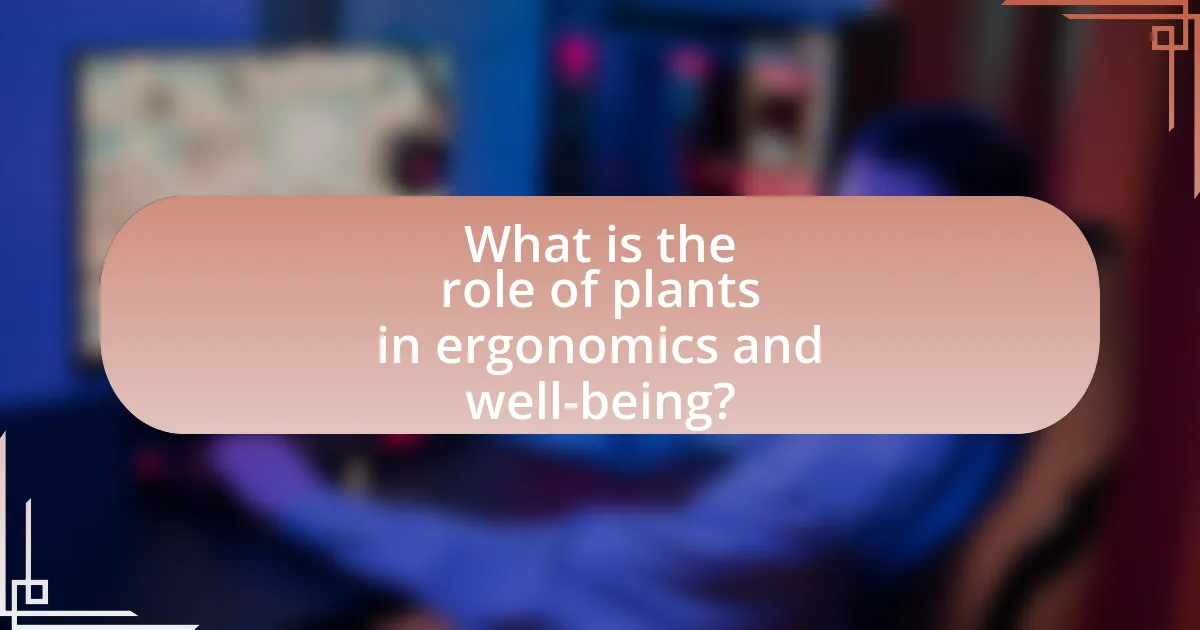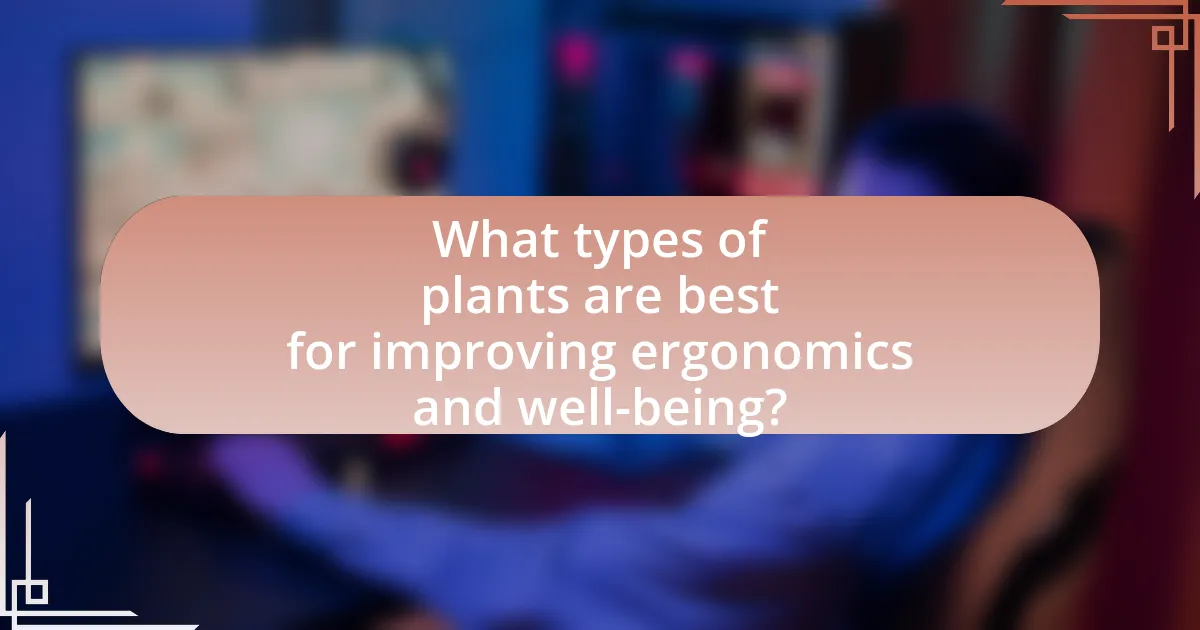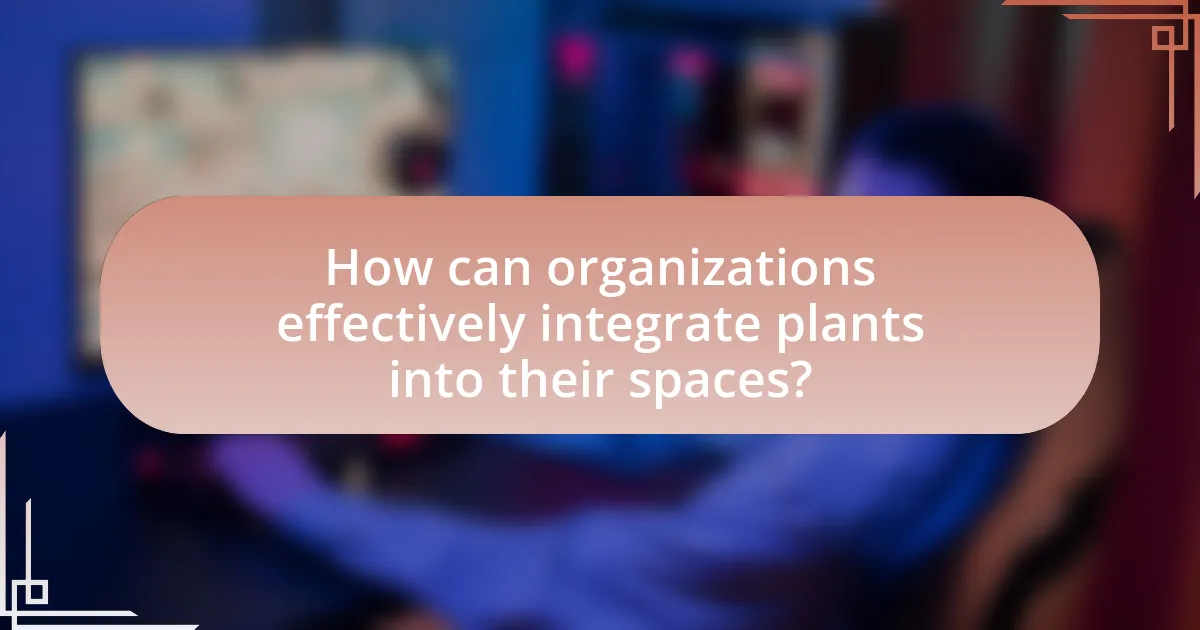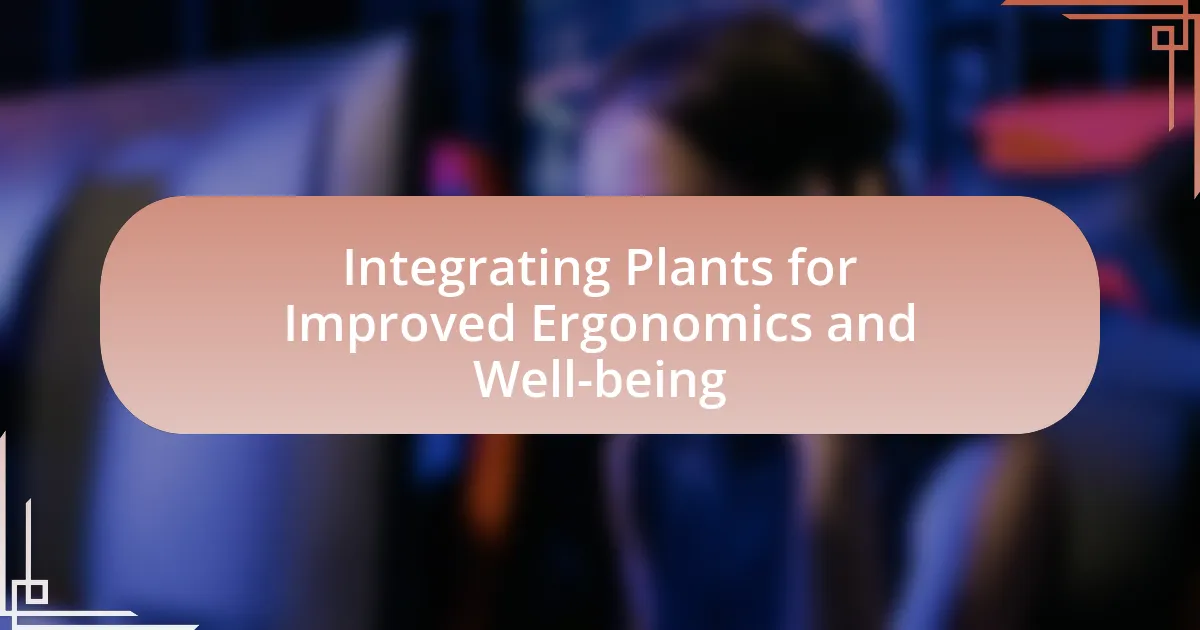The article focuses on the integration of plants in workspaces to enhance ergonomics and employee well-being. It highlights the significant benefits of plants, including improved air quality, reduced stress levels, and increased productivity, supported by various studies. The article discusses specific types of plants that are effective for air purification and stress reduction, as well as strategies for successful plant placement and maintenance in office environments. Additionally, it addresses the challenges organizations may face in integrating plants and offers practical solutions to overcome these obstacles, ultimately emphasizing the positive impact of greenery on workplace satisfaction and morale.

What is the role of plants in ergonomics and well-being?
Plants play a significant role in ergonomics and well-being by enhancing the physical and psychological environment of workspaces. Research indicates that the presence of plants can reduce stress, improve air quality, and increase productivity. For instance, a study published in the Journal of Experimental Psychology found that employees in environments with plants reported 15% higher levels of well-being and productivity compared to those in plant-free settings. Additionally, plants can help reduce noise levels and create a more aesthetically pleasing environment, contributing to overall comfort and satisfaction in workspaces.
How do plants contribute to a healthier work environment?
Plants contribute to a healthier work environment by improving air quality and enhancing employee well-being. They absorb carbon dioxide and release oxygen, which can lead to increased productivity and reduced fatigue. Research conducted by NASA in the late 1980s demonstrated that certain indoor plants can remove harmful toxins from the air, such as formaldehyde and benzene, thereby promoting a cleaner atmosphere. Additionally, studies have shown that the presence of plants can reduce stress levels and increase job satisfaction, leading to a more positive workplace culture.
What specific ergonomic benefits do plants provide?
Plants provide specific ergonomic benefits by enhancing workplace comfort and reducing stress. The presence of plants in work environments has been shown to improve air quality, which can lead to increased concentration and productivity. Studies indicate that indoor plants can reduce symptoms of discomfort, such as headaches and fatigue, by lowering levels of volatile organic compounds (VOCs) and increasing humidity. For instance, research published in the Journal of Environmental Psychology found that employees in environments with plants reported a 15% increase in well-being and a 20% increase in productivity. Additionally, plants can create a more visually appealing workspace, which contributes to overall job satisfaction and mental health.
How do plants influence mental well-being in workspaces?
Plants significantly enhance mental well-being in workspaces by reducing stress and improving mood. Research indicates that the presence of plants can lower cortisol levels, which are associated with stress, and increase feelings of relaxation and comfort. A study published in the Journal of Environmental Psychology found that employees working in environments with plants reported higher levels of job satisfaction and lower levels of anxiety. Additionally, plants improve air quality, which can lead to better cognitive function and concentration, further contributing to a positive mental state.
Why is integrating plants important for employee productivity?
Integrating plants is important for employee productivity because they enhance the work environment, leading to improved focus and reduced stress levels. Research indicates that the presence of plants in the workplace can increase productivity by up to 15%, as they contribute to better air quality and create a more aesthetically pleasing atmosphere. A study published in the Journal of Experimental Psychology found that employees working in environments with plants reported higher levels of satisfaction and lower levels of fatigue, which directly correlates to increased productivity.
What studies support the link between plants and productivity?
Studies indicate a positive link between plants and productivity, notably through research conducted by the University of Exeter, which found that incorporating plants in office environments can increase productivity by up to 15%. Additionally, a study published in the Journal of Experimental Psychology demonstrated that employees working in environments with greenery reported higher levels of concentration and lower levels of stress. These findings underscore the beneficial impact of plants on workplace productivity and employee well-being.
How do plants affect employee satisfaction and morale?
Plants significantly enhance employee satisfaction and morale by improving the workplace environment. Research indicates that the presence of plants can reduce stress levels, increase feelings of well-being, and boost overall job satisfaction. A study published in the Journal of Environmental Psychology found that employees working in environments with plants reported a 15% increase in productivity and a notable reduction in anxiety and fatigue. Furthermore, plants contribute to better air quality, which has been linked to improved cognitive function and mood among employees.

What types of plants are best for improving ergonomics and well-being?
The best types of plants for improving ergonomics and well-being include snake plants, peace lilies, and pothos. Snake plants are known for their air-purifying qualities, which can enhance indoor air quality and reduce fatigue. Peace lilies not only improve air quality but also increase humidity, which can alleviate dry skin and respiratory issues. Pothos are resilient and effective at removing toxins from the air, contributing to a healthier workspace. Research indicates that incorporating these plants can lead to increased productivity and reduced stress levels, supporting overall well-being in ergonomic environments.
Which indoor plants are most effective for air quality improvement?
The indoor plants most effective for air quality improvement include the Spider Plant, Peace Lily, and Snake Plant. These plants are known for their ability to filter common indoor pollutants such as formaldehyde, benzene, and carbon monoxide. Research conducted by NASA in the late 1980s identified these plants as part of their Clean Air Study, which demonstrated that certain houseplants can significantly reduce indoor air pollution levels. For instance, the Peace Lily can remove up to 60% of airborne toxins in 24 hours, making it a highly effective choice for enhancing indoor air quality.
What are the top air-purifying plants for office spaces?
The top air-purifying plants for office spaces include the Snake Plant, Spider Plant, Peace Lily, Pothos, and Bamboo Palm. These plants are known for their ability to filter indoor air pollutants such as formaldehyde, benzene, and carbon monoxide. For instance, the Snake Plant can convert CO2 into oxygen at night, making it suitable for office environments. Research by NASA in the Clean Air Study identified these plants as effective in improving indoor air quality, demonstrating their capacity to enhance well-being in workspaces.
How do these plants contribute to overall health benefits?
Plants contribute to overall health benefits by improving air quality, enhancing mood, and reducing stress levels. Specific plants, such as snake plants and peace lilies, are known to filter indoor air pollutants, which can lead to better respiratory health. Studies have shown that the presence of plants in indoor environments can lower stress and anxiety, as evidenced by research published in the Journal of Physiological Anthropology, which found that interacting with plants can significantly reduce physiological and psychological stress. Additionally, plants can boost productivity and cognitive function, as demonstrated in a study by the University of Exeter, which revealed that employees in green office environments reported a 15% increase in productivity.
What are the best plants for reducing stress in the workplace?
The best plants for reducing stress in the workplace include the Peace Lily, Snake Plant, and Spider Plant. Peace Lilies are known for their air-purifying qualities and ability to thrive in low light, which can create a calming environment. Snake Plants are resilient and improve indoor air quality by converting CO2 into oxygen at night, promoting a restful atmosphere. Spider Plants are also effective at removing toxins from the air and are easy to care for, making them ideal for busy workspaces. Studies have shown that incorporating greenery into office settings can lead to reduced stress levels and increased productivity, supporting the benefits of these specific plants.
Which plants are known for their calming effects?
Lavender, chamomile, and valerian are plants known for their calming effects. Lavender contains compounds like linalool and linalyl acetate, which have been shown to reduce anxiety and improve sleep quality. Chamomile is often used in herbal teas and has been linked to decreased symptoms of anxiety and insomnia due to its apigenin content, which binds to specific receptors in the brain. Valerian root is recognized for its sedative properties, with studies indicating its effectiveness in improving sleep and reducing anxiety levels.
How can the presence of these plants enhance relaxation?
The presence of plants can enhance relaxation by reducing stress levels and improving mood. Studies have shown that indoor plants can lower cortisol levels, a hormone associated with stress, thereby promoting a sense of calm. For instance, research published in the Journal of Physiological Anthropology found that participants in environments with plants reported lower levels of anxiety and increased feelings of comfort. Additionally, the presence of greenery can improve air quality, which contributes to overall well-being and relaxation.

How can organizations effectively integrate plants into their spaces?
Organizations can effectively integrate plants into their spaces by strategically placing them in areas that enhance aesthetics, improve air quality, and promote employee well-being. Research indicates that incorporating plants in work environments can reduce stress levels by up to 37% and increase productivity by 15%, as shown in a study published in the Journal of Experimental Psychology. Additionally, using a variety of plant types, such as low-maintenance options like snake plants and pothos, can cater to different lighting conditions and care preferences, ensuring sustainability in plant integration.
What strategies can be employed for plant placement in work environments?
Effective strategies for plant placement in work environments include selecting appropriate plant species, considering light and space availability, and positioning plants to enhance employee well-being. Research indicates that plants like snake plants and pothos are low-maintenance and thrive in various lighting conditions, making them suitable for office settings. Additionally, placing plants near workstations can improve air quality and reduce stress, as studies show that greenery in the workplace can lead to increased productivity and job satisfaction. Proper placement should also account for safety and accessibility, ensuring that plants do not obstruct pathways or create hazards.
How does plant placement affect employee interaction and collaboration?
Plant placement significantly enhances employee interaction and collaboration by creating inviting spaces that encourage socialization. Research indicates that strategically placed plants can improve air quality and reduce stress, leading to a more relaxed atmosphere conducive to communication. For instance, a study published in the Journal of Environmental Psychology found that workplaces with greenery fostered higher levels of employee satisfaction and teamwork. This suggests that when plants are integrated into office layouts, they not only beautify the environment but also promote a culture of collaboration among employees.
What considerations should be made for plant maintenance?
Effective plant maintenance requires regular watering, appropriate lighting, and pest management. Regular watering ensures that plants receive adequate moisture, which is essential for their growth and health. Appropriate lighting, whether natural or artificial, is crucial as different plants have varying light requirements that affect their photosynthesis and overall vitality. Pest management involves monitoring for signs of infestations and implementing control measures to protect plant health. These considerations are vital for maintaining the aesthetic and air quality benefits that plants provide in environments focused on ergonomics and well-being.
What are the challenges of integrating plants in office settings?
Integrating plants in office settings presents challenges such as maintenance requirements, space limitations, and potential allergies among employees. Regular care, including watering and pruning, is necessary to keep plants healthy, which can be a burden for staff with busy schedules. Additionally, limited office space may restrict the number and size of plants that can be accommodated, impacting the overall aesthetic and benefits. Furthermore, some individuals may experience allergic reactions to certain plants, necessitating careful selection to ensure a comfortable environment for all employees.
How can organizations overcome common obstacles to plant integration?
Organizations can overcome common obstacles to plant integration by implementing a structured approach that includes stakeholder engagement, clear communication, and tailored design strategies. Engaging stakeholders ensures that the needs and preferences of employees are considered, which can enhance acceptance and support for plant integration. Clear communication about the benefits of plants, such as improved air quality and reduced stress, can help mitigate resistance. Tailored design strategies, such as selecting appropriate plant species for specific environments and ensuring proper maintenance, can address practical challenges. Research indicates that workplaces with integrated plants can lead to a 15% increase in employee satisfaction and a 6% boost in productivity, demonstrating the effectiveness of these strategies in overcoming integration obstacles.
What solutions exist for managing plant care in busy workplaces?
Solutions for managing plant care in busy workplaces include automated irrigation systems, low-maintenance plant selections, and plant care services. Automated irrigation systems provide consistent watering schedules, reducing the need for manual care. Low-maintenance plants, such as succulents and snake plants, require less frequent attention and are resilient to varying light conditions. Additionally, hiring plant care services can ensure professional maintenance, allowing employees to focus on their work while maintaining a healthy plant environment. These solutions enhance workplace aesthetics and contribute to employee well-being by improving air quality and reducing stress.
What practical tips can organizations follow for successful plant integration?
Organizations can achieve successful plant integration by strategically selecting plant species that thrive in indoor environments and align with the specific lighting and humidity conditions of the workspace. Research indicates that plants such as snake plants and pothos are resilient and require minimal maintenance, making them ideal for office settings. Additionally, organizations should consider placing plants in high-traffic areas to enhance visibility and engagement, as studies show that proximity to greenery can improve employee mood and productivity. Regular maintenance and care routines should be established to ensure plant health, which contributes to a positive aesthetic and air quality. Furthermore, involving employees in the selection and placement of plants fosters a sense of ownership and connection to the workspace, ultimately enhancing overall well-being.


